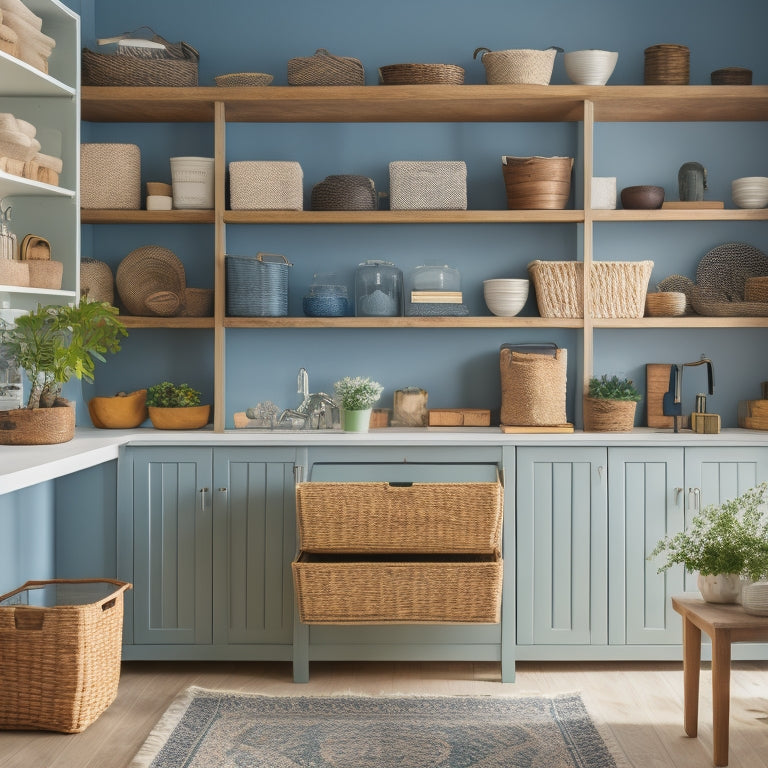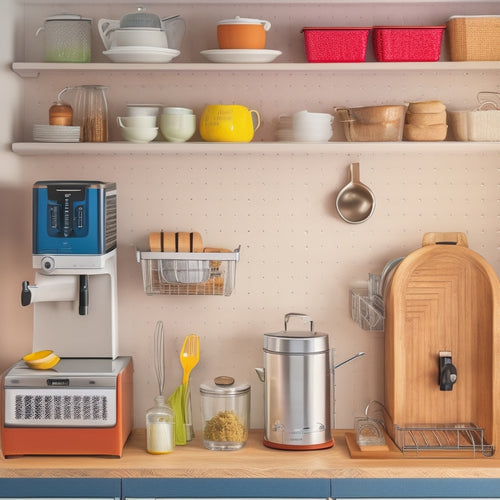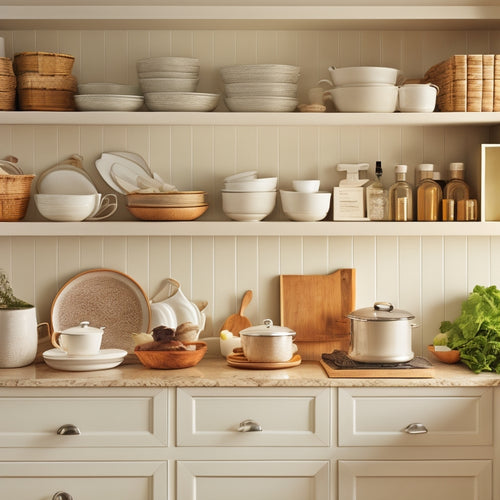
10 Essential Tips for Affordable Home Storage Systems
Share
You're ready to create a more streamlined and functional living space on a budget. Start by evaluating your storage needs, measuring your available space, and choosing multi-functional furniture. Utilize vertical storage options, invest in stackable containers, and keep frequently used items accessible. Consider DIY storage solutions, shop secondhand for unique pieces, and store items out of sight. By following these essential tips, you'll be well on your way to an affordable home storage system that works for you. Now, get ready to discover the secrets to a more organized, clutter-free life.
Key Takeaways
• Assess storage needs by identifying clutter patterns, lifestyle changes, and daily routines to create an effective and affordable storage system.
• Measure available space precisely and consider the size and shape of items to maximize storage capacity and optimize the system.
• Utilize multi-functional furniture, vertical storage, and stackable containers to reduce clutter, save space, and stay organized.
• Create an inventory management system to track stored items and their locations, ensuring efficient tracking and organization.
• Explore DIY storage solutions, secondhand shopping, and hidden storage compartments to create a customized and budget-friendly storage system.
Assess Your Storage Needs First
Before investing in a home storage system, take stock of your belongings and habits to determine what you need to store and how you need to store it. You'll want to identify your clutter patterns - do you tend to accumulate paper clutter, or do you have a habit of holding onto sentimental items? Be honest with yourself about your lifestyle changes, too. Are you downsizing, or do you have a growing family? Understanding your needs will help you choose a storage system that works for you, not against you.
Consider your daily routines and habits. Do you have a dedicated workspace, or do you work from the kitchen table? Do you have a lot of outdoor gear or sports equipment that needs to be stored? Take note of the items you use frequently and those that can be stored away for longer periods.
Think about the flow of your home and how you move through each room. By understanding your storage needs, you'll be able to create a system that's functional, efficient, and tailored to your unique situation. This will save you time, money, and stress in the long run.
Measure Your Available Space
You'll need to take precise measurements of your available space to determine the maximum capacity of your storage system. This step is essential in ensuring you get the most out of your storage system without overcrowding the room. Grab a tape measure and record the room dimensions, including the length, width, and height of each wall. Don't forget to measure any obstructions like windows, doors, or pillars.
Next, use a space calculator to calculate the total square footage of your room. This will give you an accurate idea of how much space you have to work with. Make note of any areas with limited accessibility, such as tight corners or narrow pathways.
Consider the size and shape of the items you need to store, and think about how you can optimize your storage system to accommodate them.
Choose Multi-Functional Furniture
When selecting furniture, you'll want to choose multi-functional pieces that serve more than one purpose. This will help you maximize your available space and reduce clutter.
Space-Saving Furniture Options
Opt for multi-functional furniture pieces that serve dual purposes, like a storage ottoman that doubles as a coffee table, to maximize your space without sacrificing functionality. By choosing furniture with multiple uses, you'll reduce clutter and create a more organized living space. This is especially important in small homes or apartments where every inch counts.
Here are some space-saving furniture options worth exploring:
- Storage beds with built-in drawers or shelves
- Desks with built-in shelving or cabinets
- Ottoman storage cubes that can be used as additional seating
- Compact dining tables with leaf extensions
- Murphy tables that fold up against the wall when not in use
These furniture hacks will help you make the most of your compact designs, allowing you to live comfortably in a smaller space.
Optimizing Hidden Storage Spaces
Take advantage of often-overlooked areas like under-bed storage, hollowed-out books with secret compartments, and decorative storage bins to stash items out of sight, freeing up valuable floor space for more functional uses. By doing so, you'll create a more organized and clutter-free living space.
When choosing multi-functional furniture, consider pieces with hidden storage spaces. For example:
| Furniture Piece | Hidden Storage Space | Benefits |
|---|---|---|
| Ottoman | Hollow interior for storing linens or out-of-season clothes | Doubles as a footrest or additional seating |
| Coffee Table | Lift-top with storage compartment for remotes or games | Keeps living room clutter-free |
| Headboard | Built-in shelves or cabinets for books or personal items | Maximizes bedroom storage |
| Desk | Drawers or compartments for office supplies or paperwork | Keeps workspace organized |
| Window Seat | Storage bench with hidden compartment for linens or out-of-season clothes | Provides additional seating and storage |
Utilize Vertical Storage Options
You can maximize your storage capacity by installing shelves, hooks, or storage units that go up to the ceiling, making the most of your available wall space. This is especially useful in small rooms or areas with limited floor space. By utilizing vertical storage options, you can keep your floors and surfaces clutter-free, creating a sense of openness and relaxation.
Here are some ways to effectively utilize vertical storage:
-
Install shelves with shelf dividers to separate and organize items
-
Use hanging organizers for storing items like bikes, tools, or accessories
-
Invest in floor-to-ceiling storage units for bulky items like luggage or seasonal decorations
-
Add hooks for hanging items like bags, hats, or keys
-
Consider installing a pegboard for hanging frequently used items like utensils or cleaning supplies
Invest in Stackable Containers
When investing in stackable containers, you'll want to maximize your vertical space by selecting containers that fit your shelves or storage areas perfectly.
You'll also need to choose the right size containers for the items you're storing, ensuring you can easily access what you need without having to dig through everything.
Maximize Vertical Space
By investing in stackable containers, your storage capacity increases exponentially, allowing you to make the most of your home's vertical space. This is especially important in areas with limited floor space, where every inch counts. By maximizing your vertical space, you can store more items without cluttering your floors or surfaces.
Here are some ways to maximize your vertical space:
-
Install wall shelves to store infrequently used items, such as seasonal decorations or out-of-season clothing
-
Use ceiling hooks to hang bikes, luggage, or other bulky items, keeping them out of the way
-
Invest in stackable bins or baskets to store items like linens, toys, or cleaning supplies
-
Consider a storage loft or attic storage for items that are only used occasionally
-
Utilize the space above your closet rod by installing a shelf or storage unit for folded items or out-of-season clothing
Choose the Right Size
Choose the Right Size
Your storage needs dictate the ideal size of your stackable containers, so it's important to assess the items you plan to store before making a purchase. Consider the room layout and furniture proportions to make sure the containers fit seamlessly into your space. Measure the area where you'll be placing the containers to determine the maximum size that will fit comfortably.
Don't forget to think about the items you'll be storing – if you have bulky items, you'll need larger containers, while smaller items can be stored in smaller ones.
When choosing the size of your stackable containers, remember that it's better to have multiple smaller containers than a few large ones. This will give you more flexibility when it comes to storing different items and allow you to use vertical space more efficiently. Additionally, smaller containers are often easier to move around and can be easily rearranged as your storage needs change.
Label and Sign Everything Clearly
Organize your storage space efficiently by labeling and signing everything clearly, so you can instantly identify what's inside each container or shelf. This simple yet effective strategy saves you time and frustration when searching for specific items. By labeling each container or shelf, you'll avoid digging through multiple boxes or bins to find what you need.
Here are some labeling tips to get you started:
- Use a color-coding system to categorize items based on type or room
- Create an inventory management system to track stored items and their locations
- Label containers with their contents and the date they were stored
- Consider using pictures or icons for labels if you're a visual person
- Keep labels consistent with font, size, and style throughout your storage space
Keep Frequently Used Items Accessible
Make the most of your storage space by storing frequently used items in easy-to-reach locations, saving you time and energy in the long run. This way, you'll have quick retrieval of your daily essentials, making your life more convenient.
For instance, store your frequently used kitchen utensils near the cooking area, and keep your favorite cleaning supplies under the sink. This will prevent you from having to search for them every time you need them.
Designate specific zones for your daily essentials, such as a 'launching pad' near the front door for your keys, wallet, and bag. This will help you stay organized and avoid clutter.
You can also use baskets, bins, or hooks to store items like toilet paper, towels, and cleaning supplies, making them easily accessible.
Consider DIY Storage Solutions
You can also explore DIY storage solutions to maximize your space and tailor your storage to your specific needs. By taking on DIY projects, you can create custom builds that fit your unique requirements and decor. Plus, you can get creative with repurposed materials to reduce waste and save money.
Here are some DIY storage ideas to get you started:
-
Upcycle old pallets into shelving units or coffee tables with storage
-
Transform mason jars into decorative containers for small items
-
Build a storage headboard using reclaimed wood and fabric bins
-
Create a pegboard using an old door and hooks for hanging accessories
-
Design a hidden storage compartment behind a mirror or artwork
Shop Secondhand for Storage Items
Scouring secondhand stores, online marketplaces, and garage sales can yield unique, gently-used storage items that fit your style and budget. You can find hidden gems that not only save you money but also add a touch of personality to your space. Thrift shopping and online bargain hunting can be a fun and rewarding way to discover one-of-a-kind storage solutions.
Here are some popular secondhand storage items to keep an eye out for:
| Item | Average Price | Where to Find |
|---|---|---|
| Vintage crates | $10-$20 | Thrift stores, garage sales |
| Gently-used shelving units | $20-$50 | Online marketplaces, secondhand furniture stores |
| Decorative storage baskets | $5-$15 | Estate sales, online auction sites |
When shopping secondhand, remember to inspect items carefully for damage or wear. Consider refinishing or repurposing items to give them new life. With a little creativity and patience, you can create a functional and stylish storage system on a budget.
Store Items Out of Sight
Now that you've scored some unique storage pieces on a budget, it's time to think about strategically placing them to keep clutter at bay. You want to make the most of your storage systems by utilizing hidden corners and secret compartments to stash items out of sight. This will create a sense of calm and organization in your home.
Here are some clever ways to store items out of sight:
-
Install shelves or cabinets with sliding doors to conceal items like linens, cleaning supplies, or office materials.
-
Utilize the space under your bed by using storage bins or drawers to store out-of-season clothes or bedding.
-
Hang a storage ottoman or bench in a closet to store items like hats, scarves, or bags.
-
Invest in a storage coffee table or side table with hidden compartments to store remotes, games, or other living room essentials.
-
Consider a Murphy desk or fold-down shelf to create a hidden workspace in a small area.
Frequently Asked Questions
Can I Use Storage Systems for Cluttered Outdoor Spaces Too?
You can definitely use storage systems to tackle cluttered outdoor spaces! Implement patio organization solutions, like benches with storage or vertical shelves, and focus on yard decluttering by categorizing items and assigning a home for each.
How Do I Store Items That Are Sensitive to Temperature Changes?
"When life gives you lemons, make lemonade" - and when temperature-sensitive items come knocking, you'll want climate control and thermal regulation in your storage game to keep them from turning sour; invest in insulated containers or climate-controlled units.
Are There Any Eco-Friendly Storage Container Options Available?
You'll be glad to know that eco-friendly storage container options are available! Look for bamboo containers, which are biodegradable and compostable, or opt for containers made from recycled materials, reducing waste and minimizing environmental impact.
Can I Use Storage Systems to Create a Home Office Space?
Can you really focus in a cluttered space? You can create a functional home office by using storage systems for desk organization and effective space planning, allowing you to stay focused and productive.
Are There Any Storage Systems Suitable for Small Children's Toys?
You'll find plenty of storage systems perfect for small children's toys! Look for kid-friendly, easy-to-use options like stackable bins, shelves with guards, and toy organization systems with colorful labels to keep their play areas tidy.
Related Posts
-

Smart Storage for Small Kitchen Appliances
You can optimize your small kitchen's functionality by implementing smart storage solutions that efficiently stash sm...
-

Why Kitchen Cabinet Organization Matters Most
You're likely losing more than just time and ingredients when you can't find what you need in your kitchen cabinets -...

